Test / E-Bike: Mit dem Pinion E-Drive System bzw. der Pinion MGU gibt es einen neuen spannenden Namen bei den E-Bike Antrieben. Als Kombination aus Getriebeschaltung und Mittelmotor ist er derzeit einzigartig auf dem Markt. Eine klassische Schaltung wird damit überflüssig, egal ob am Citybike oder am E-MTB. Wir haben uns das neue System genau angesehen, auf dem Prüfstand und in der Praxis getestet.
Als Redakteur in der Fahrradbranche darf man viele Male im Jahr neue Produkte und Räder ausprobieren, testen und begutachten. Spannend ist davon vieles, doch nur selten ist ein Produkt dabei, bei dem man das Gefühl hat: Das wird den Markt verändern – nachhaltig. Genau so verhält es sich mit dem Pinion E-Drive System bzw. der Pinion MGU. Mittelmotor und Getriebeschaltung in einer Einheit, beides auf dem aktuellsten Stand der Technik, dabei quasi wartungsfrei und ohne Mehrgewicht. Entwickelt und hergestellt in Deutschland und direkt zum Start mit zahlreichen namhaften Partnern und vielen unterschiedlichen Bikes vom Enduro E-MTB über Kompakträder bis hin zum Cargobike. Das ist bahnbrechend.
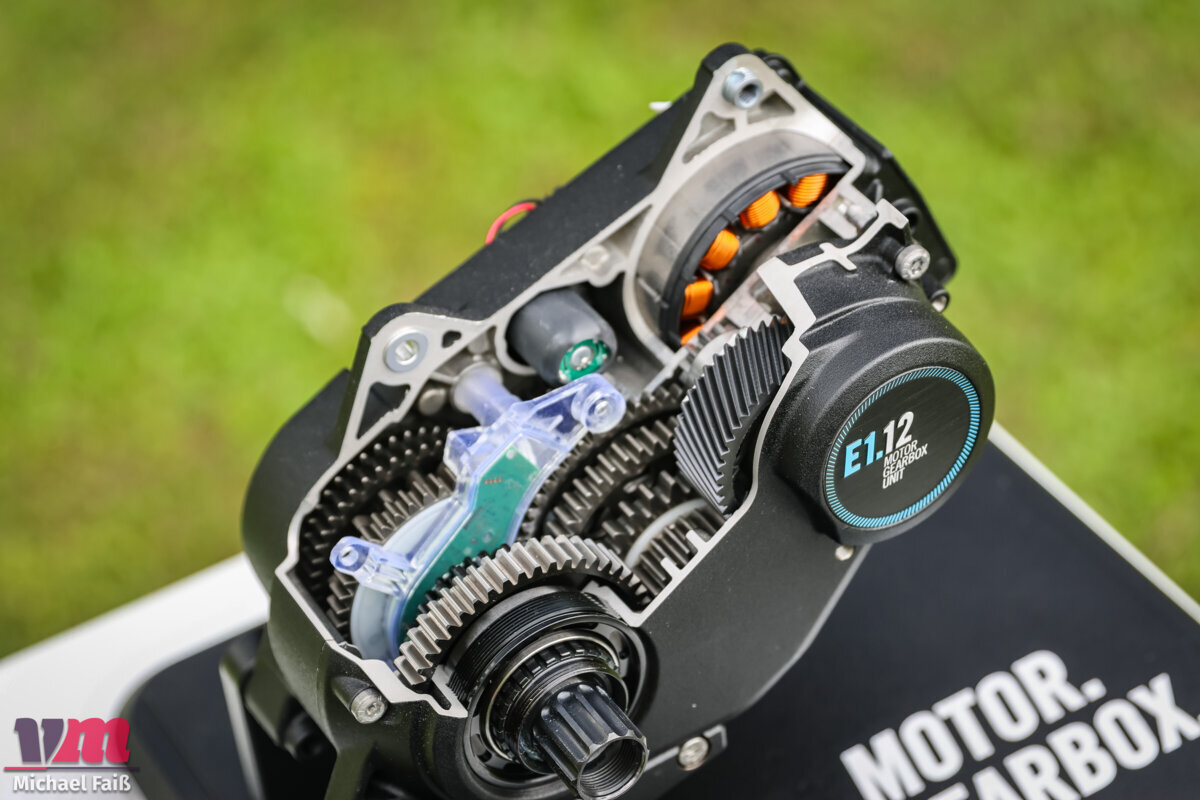
Mit Getriebe Know-How zum E-Antrieb
Pinion ist dabei gewiss kein neuer Name in der Branche, dürfte dennoch nicht jedem geläufig sein. Der Hersteller mit Sitz in Denkendorf nahe Stuttgart ist seit 2008 auf dem Markt vertreten und konnte sich bislang mit innovativen Schaltgetrieben vor allem unter Reiseradlern einen guten Ruf erarbeiten. Schon kurze Zeit nach der Gründung begann jedoch die Entwicklung von dem, was die Schwaben heute unter dem Namen Pinion MGU vorstellen: Die Kombination der bewährten Getriebe mit einem Elektromotor. Zwölf Jahre nach der ersten Idee ist dieses Produkt nun also Realität geworden und stellt ein echtes Novum auf dem E-Bike Markt dar.
Noch mehr Infos und ausführliche Eindrücke gibt es in unserem Testvideo:
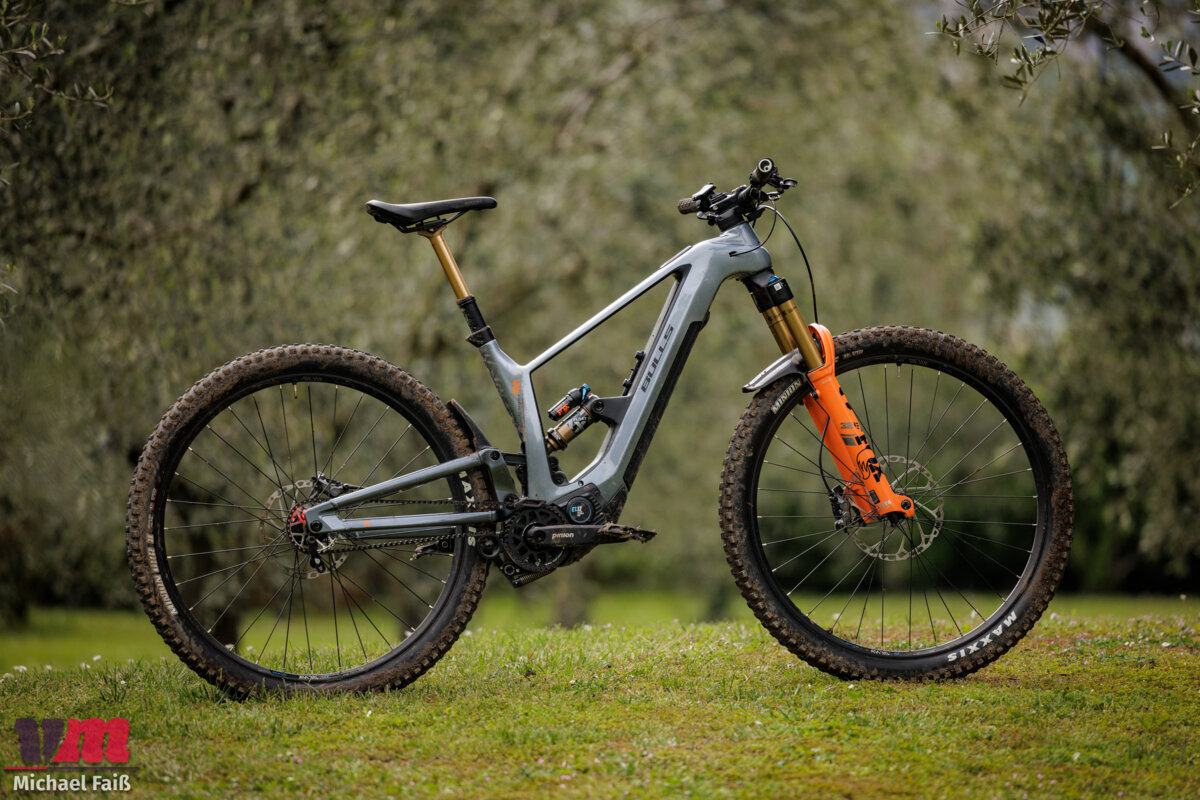
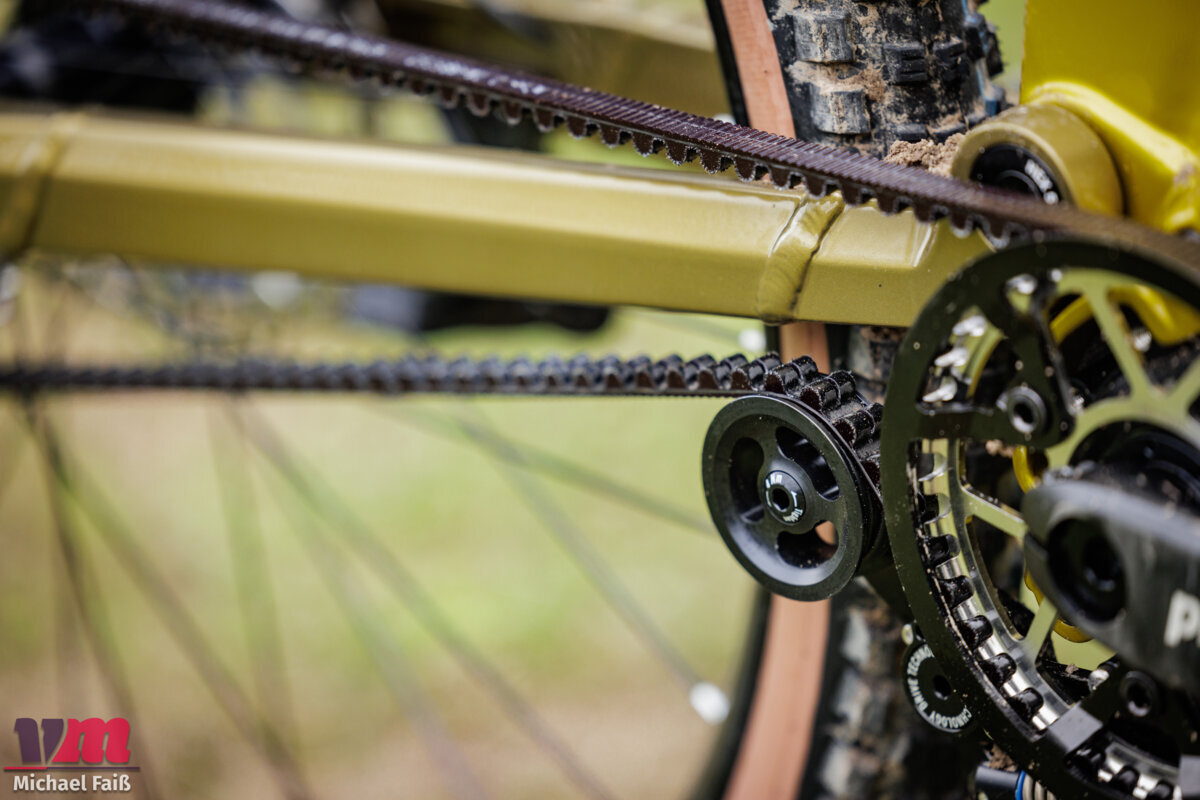
An die Trennung des Antriebs am E-Bike in Motor und Schaltung hat man sich gewöhnt. Sie ist organisch aus der Historie des Fahrrads gewachsen und man kennt nun einmal nichts anderes. Aber: Aus technischer Sicht bringt die Aufteilung des Antriebsstrangs einige Probleme mit sich: Die Kommunikation zwischen den beiden Teilen ist komplex und oft nicht vorhanden. Auch wenn einige moderne Systeme wie z.B. Shimano Di2 oder Bosch eShift versuchen, hier anzusetzen, handelt es sich dennoch um zwei getrennte Komponenten, die nicht selten in Konkurrenz stehen – Stichwort Schalten unter Last. Genau an diesen Punkten setzt die Pinion MGU an.
Schaltung: 12 oder 9 Gänge, bis zu 600% Bandbreite
Für das integrierte Schaltgetriebe konnte Pinion auf die Erfahrung aus der eigentlichen Kernkompetenz zurückgreifen. Das Ergebnis ist beeindruckend. Die Pinion MGU ist als Variante mit neun oder zwölf Gängen erhältlich mit einer Gesamtübersetzung von 568% bzw. 600%. Beeindruckende Zahlen – im Kosmos der Getriebeschaltungen kann hier allenfalls die Rohloff E14 mithalten und selbst moderne Kettenschaltungen von Sram oder Shimano reichen nicht an diese Bandbreite heran. Dazu kommen die systembedingten Vorzüge einer Getriebeschaltung: Gangwechsel im Stand? kein Problem! Gangsprünge? gleichmäßig. Verschleiß? nicht vorhanden!

Bandbreite verschiedener Schaltungen im Vergleich
| Art | Gänge | Bandbreite | |
|---|---|---|---|
| Pinion E1.9 | Getriebe | 9 | 568% |
| Pinion E1.12 | Getriebe | 12 | 600% |
| Shimano XT | Kette | 12 | 510% |
| Sram Eagle | Kette | 12 | bis 520% |
| Shimano XT Linkglide | Kette | 11 | 455% |
| Rohloff Speedhub | Getriebe | 14 | 526% |
| Enviolo | Getriebe | stufenlos | 309% |
| Shimano Nexus Inter 5E | Getriebe | 5 | 263% |
Die Gangwechsel erfolgen dabei in Sekundenbruchteilen, dank der Kommunikation zwischen Motor und Getriebe auch unter Last ohne Aussetzen der Unterstützung. Der Impuls zum Gangwechsel kommt von einem kompakten Trigger Schalthebel am Lenker und wird elektronisch übermittelt. Damit entfällt auch das Ein- oder Nachstellen der Schaltung. Smart.Shift nennt Pinion sein Schaltsystem. Übrigens: Selbst bei „leerem“ Akku sind mit dem System noch ca. 1.000 Schaltvorgänge möglich.
Motor mit beeindruckenden Leistungsdaten
So beeindruckend das Schaltgetriebe jedoch auch sein mag – wirklich einzigartig wird das Pinion E-Drive System bzw. die Pinion MGU durch die Kombination mit einem Motor. Als Basis dient ein in Deutschland hergestellter, bürstenloser Motor für industrielle Anwendungen, der für das E-Bike angepasst wurde.
Seine Leistungsdaten sind dabei nicht weniger imposant als die der Schaltung. Pinion gibt eine Motorleistung von 600 W für die Pedelec-Variante und 800 W für das S-Pedelec Pendant an. Unsere Prüfstandsmessungen konnten dies bestätigen. Nach Abzug der Verlustleistung konnten wir eine Motorleistung von ca. 580 W erreichen, womit die Pinion MGU ebenso kräftig bzw. sogar ein Stück kräftiger ist als die meisten anderen Mittelmotoren auf dem Markt wie beispielsweise ein Bosch Performance CX.
Ein wenig komplizierter verhält sich die Angabe des maximalen Drehmoments. Durch das integrierte Schaltgetriebe ist das Drehmoment an der Antriebswelle nicht direkt mit anderen Antrieben vergleichbar. Man spricht hier deshalb von einem „vergleichbaren Antriebsdrehmoment von ca. 85 Nm“ bei einer virtuellen 1:1 Übersetzung. Am Hinterrad sollen in den Gängen eins bis vier aber sogar bis zu 160 Nm ankommen. Ein Wert, der so jedoch von anderen Herstellern nicht angegeben wird.
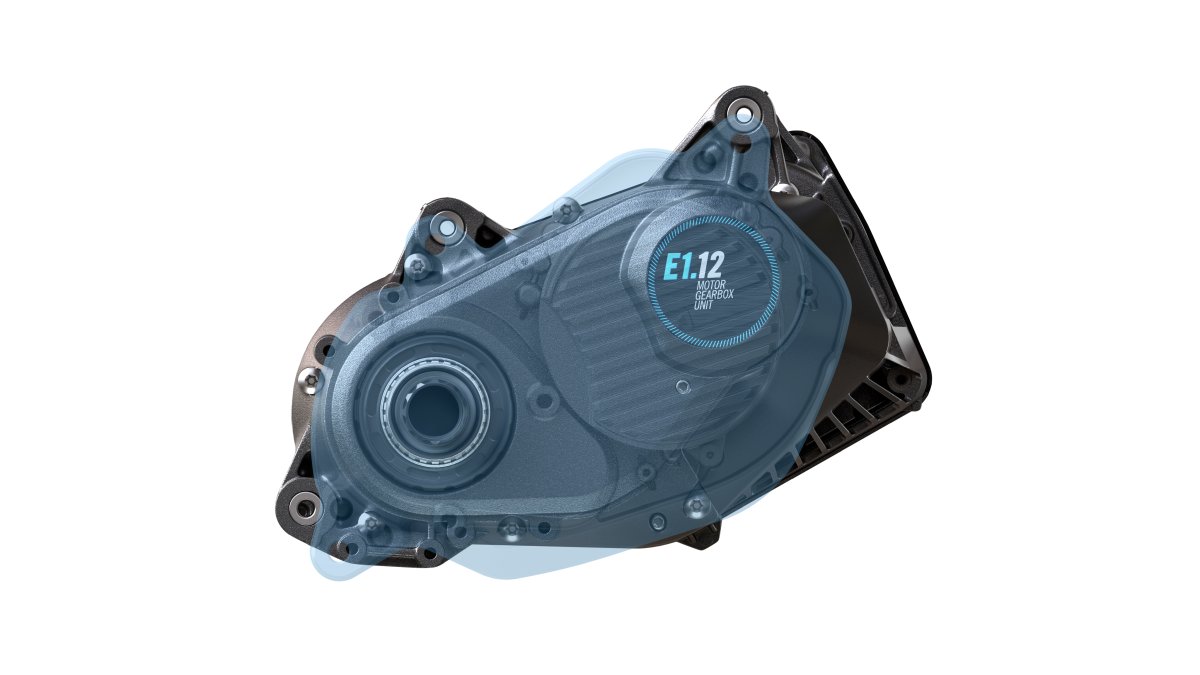
Vier Unterstützungsstufen und zwei Grund-Tunes
Aus vier Unterstützungsstufen kann man als Fahrer des Pinon E-Drive Systems wählen: Eco, Flow, Flex und Fly. Bei den Modi Flow und Flex handelt es sich um adaptive Modi, die die Unterstützung dynamisch auf den Pedaldruck anpassen, ähnlich wie z.B. der eMTB Modus bei Bosch Antrieben. In allen Unterstützungsstufen ausgenommen Fly hat man außerdem die Möglichkeit, auf Knopfdruck die maximale Leistung aus dem System zu kitzeln, ohne dabei den Modus selbst wechseln zu müssen.
Spannend ist außerdem die integrierte Schiebehilfe, die gleichzeitig als Anfahrhilfe fungiert. Nach der Aktivierung über die Remote wechselt das System in seinen effektivsten Gang und gibt Gas. Dabei kann man es sich schon auf dem Sattel bequem machen, der Antrieb schiebt dennoch an: So ist ein nahtloser Wechsel von Anfahren zum Treten im technischen Gelände deutlich einfacher.
Grundsätzlich kommt das Pinion E-Drive System in zwei Tunes: Comfort und Performance. Die jeweiligen Fahrradhersteller können diese abhängig vom Einsatzgebiet auswählen. Das Performance Setup dürfte insbesondere an E-MTBs zum Einsatz kommen mit schnellerer Leistungsentfaltung und einem dynamischeren Ansprechverhalten, wohingegen sich die Räder mit Comfort Tune harmonischer und natürlicher anfühlen sollen. Wer möchte, kann alle Unterstützungsstufen jedoch auch nach dem Kauf über die Fit E-Bike Control App auf die eigenen Wünsche und Bedürfnisse anpassen.
Pinion E-Drive System: Die Kombination macht’s!
Beide Komponenten der Pinion MGU – Motor und Schaltung – sind also für sich genommen bereits durchaus beeindruckend. Der wirkliche Clou ist jedoch ihre Kombination in einer einzigen Einheit. So weiß der Motor zu jedem Zeitpunkt, welcher Gang eingelegt ist und kann seine eigene Drehzahl abhängig davon und von der getretenen Kadenz anpassen. So soll sich ein deutlich runderes, harmonischeres Fahrgefühl einstellen als bei der klassischen Kombination aus Schaltung am Hinterrad und Mittelmotor am Tretlager.
Diese Kombination ermöglicht auch intelligente Schaltfunktionen wie Pre.Select und Start.Select. In beiden Fällen handelt es sich gewissermaßen um eine Halb-Automatik: Start.Select legt auf Wunsch beim Anhalten einen vordefinierten Gang ein, um das Anfahren zu erleichtern. Pre.Select geht einen Schritt weiter: Nach dem Festlegen einer Wunsch-Kadenz wechselt das System während des „Rollens“, also z.B. in der Abfahrt, immer in den passenden Gang, abhängig von der aktuellen Geschwindigkeit.

All das – also Motor und Getriebe – steckt gemeinsam in einem geschlossenen Magnesiumgehäuse, das nur wenig größer ist als moderne Mittelmotoren. Beim Gewicht liegt es mit 4.000 g (9 Gang) bzw. 4.100 g (12 Gang) etwas über dem „nackter“ Mittelmotoren, jedoch relativiert sich dies dadurch, dass ein E-Bike mit Pinion E-Drive System komplett auf eine herkömmliche Schaltung verzichten kann.
| Motor | Schaltung | Gewicht |
|---|---|---|
| Pinion MGU 9-Gang | - | 4.000 g |
| Pinion MGU 12-Gang | - | 4.100 g |
| Bosch Performance CX | Shimano XT 12-fach | 3.650 g |
| Bosch Performance CX | Shimano XT Linkglide | 3.821 g |
| Bosch Performance CX | Shimano Deore 12-fach | 3.856 g |
| Bosch Performance CX | Sram Eagle X01 AXS | 3.670 g |
| Bosch Performance CX | Sram GX Eagle | 3.652 g |
| Bosch Performance CX | Enviolo | 5.350 g |
| Bosch Performance CX | Rohloff E14 | 4.600 g |
| Bosch Performance CX | Shimano Nexus Inter 5E | 4.560 g |
Das Gewicht des Bosch Performance CX wird mit 2.900 g angerechnet und entspricht dem vieler anderer Mittelmotoren (z.B. Brose Drive S Mag). Der Shimano EP8 ist rund 300 g, der Yamaha PW-X3 rund 150 g leichter. Bei den Kettenschaltungen rechnen wir mit dem Gewicht von Schaltwerk (+evtl. Akku) und Kassette.
Durch das „Einsparen“ der Schaltung am Hinterrad ergeben sich für Fahrradhersteller ganz neue Möglichkeiten. So kommen fast alle E-Bikes mit Pinion MGU mit einem Riemenantrieb. Am E-MTB gibt es außerdem zwei handfeste Vorteile: Kein Schaltwerk mehr, das man sich im Eifer des Trail-Gefechts abreißen kann und ein zentraler Schwerpunkt. Während das Gewicht des Antriebsstrangs an einem regulären E-MTB auf Tretlager (Mittelmotor) und Hinterrad (Schaltwerk und Kassette) verteilt ist, liegt es bei einem Pinion E-MTB zentral am tiefsten Punkt des Bikes.
Pinion MGU: Extrem wartungsarm und quasi verschleißfrei
Auch in puncto Haltbarkeit und Wartung will das Pinion E-Drive System neue Maßstäbe setzen. Da sämtliche Komponenten in einem geschlossenen und komplett gedichteten Gehäuse sitzen, sind sie vor äußeren Einflüssen geschützt. Das Getriebe soll ebenso wie der Motor wartungsfrei sein und keine nennenswerten Verschleißerscheinungen zeigen. Laut Pinion wurde das System „über jede erdenkliche Bandbreite, Distanz, Beanspruchung, Nutzungsdauer und Prüfnorm hinaus getestet, die ein E-Bike erfahren kann.“
Durch seine Bauweise können sich die Gänge nicht verstellen, dank elektronischer Übertragung vom Schalthebel gibt es auch kein Verstellen der Züge. In Kombination mit einem Carbonriemen erhält man ein über sehr lange Zeit wartungsfreies System, auch am sportlichen E-MTB. Nach ca. 10.000 km ist ein Ölwechsel notwendig – dieser lässt sich aber selbst in weniger als zehn Minuten erledigen.
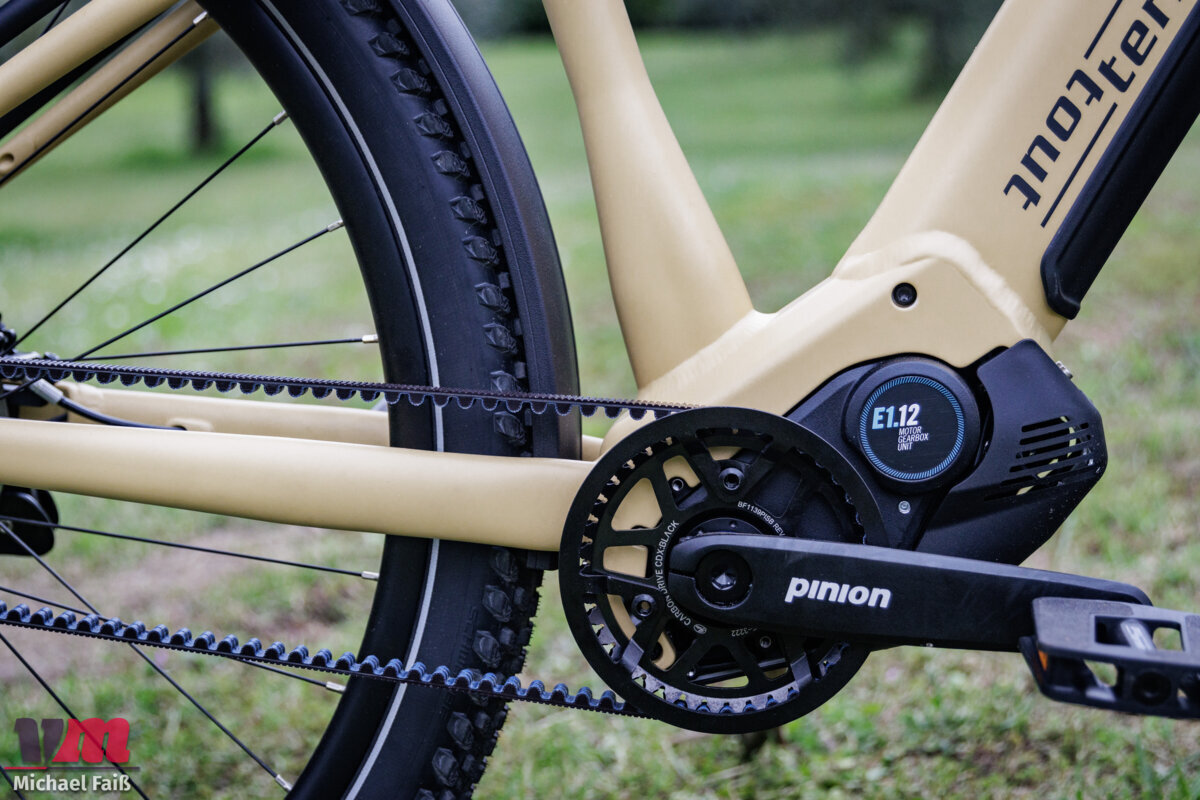
Bei solch vollmundigen Versprechen ist immer eine gewisse Skepsis angebracht. Da die bekannten Pinion Getriebe diese Versprechen jedoch halten konnten, sind wir zuversichtlich – dennoch: Es bleibt abzuwarten, inwiefern man mit dem Pinion E-Drive System wirklich einen wartungsfreien Antrieb bekommt.
Kooperation mit FIT: Akkus bis 960 Wh
Für ein komplette E-Bike System braucht es jedoch mehr als nur eine überzeugende Antriebseinheit. Deshalb hat man sich für die sonstige Peripherie mit FIT einen starken Partner ins Boot geholt. Die Schweizer kümmern sich um Software, Bedienteile, Displays, Akkus und um die App. Die Kooperation hat außerdem den großen Vorteil, dass Pinion auf ein bestehendes Netz an Fachhändlern und Partnern zurückgreifen kann, die bereits mit FIT vertraut sind.
Viel Auswahl für die Fahrradhersteller gibt es bei den Akkus: Hier kommt entweder der sogenannte Ultracore Akku mit 480, 720 oder 960 Wh zum Einsatz oder der schlanke TP700 mit 700 Wh. Zusätzlich wird auch ein Range Extender erhältlich sein mit satten 535 Wh – entsprechend kann man hier eigentlich auch fast von einem Zweit-Akku sprechen. Geladen werden sie entweder über den Standard Charger mit 4A, der sich beim Fachhändler per kostenpflichtigem Softwareupgrade zum Fast Charger mit 6A aufrüsten lässt.
Noch mehr Auswahl als bei den Akkus gibt es bei den Bedienteilen. Da das Pinion E-Drive System an unterschiedlichsten E-Bikes vom Cargobike über Citybike bis hin zum E-MTB eingesetzt wird, ist dies auch notwendig. Wer ein „echtes“ eigenes Display möchte, hat die Wahl zwischen dem großen Display Comfort und dem etwas minimalistischeren Display Compact. Kombiniert werden beide mit der Basic Remote. Alternativ kann man auch das eigene Smartphone in Kombination mit dem (kostenpflichtigen) Drive Screen der FIT E-Bike App nutzen. Noch etwas sportlicher kommt die FIT Remote Display daher, bei der im Bedienteil ein kleines Farbdisplay integriert ist. Maximal minimalistisch kommt die FIT Remote Pure, die nur ein schmaler Ring am Lenker ist und mit der sogenannten Master Node im Oberrohr kombiniert wird. Letztere werden wir voraussichtlich ab kommendem Jahr an den ersten Pinion E-MTBs sehen.

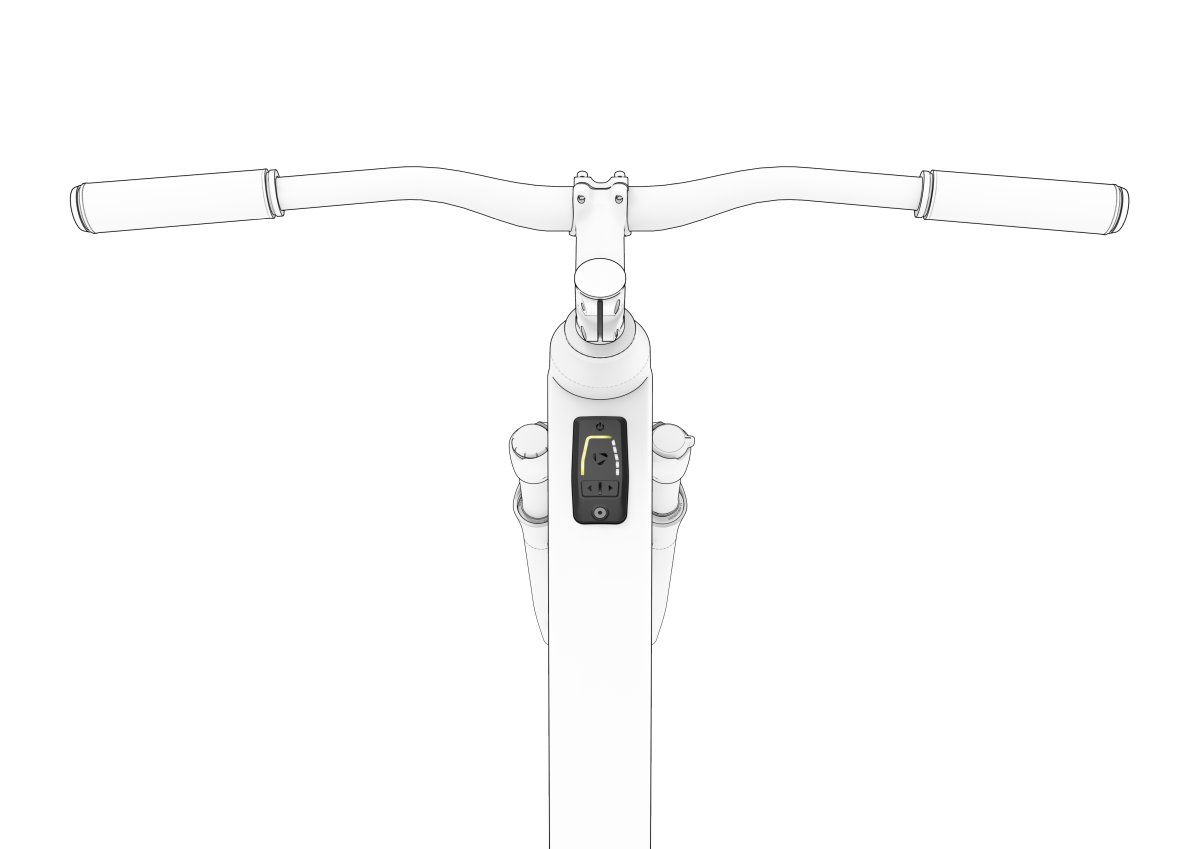
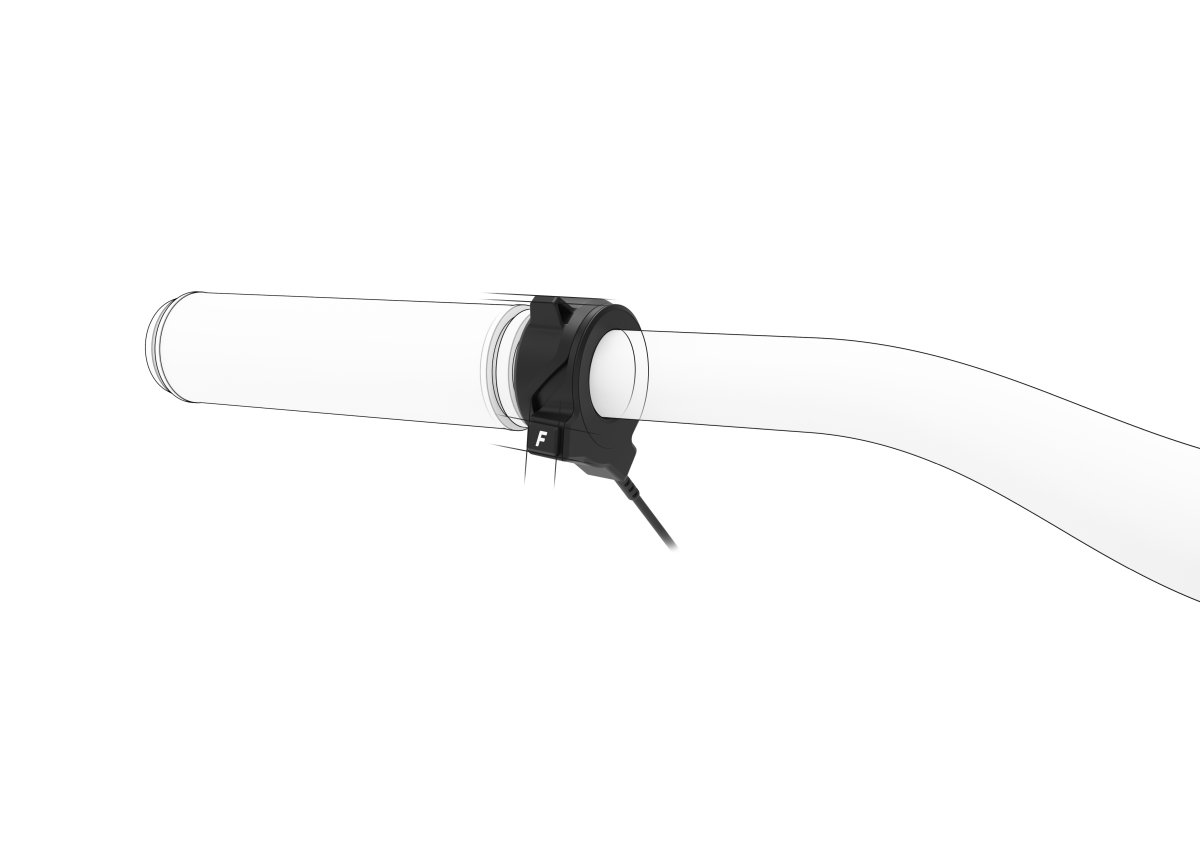
Alle Fäden des FIT-Systems laufen in der Smartphone App zusammen, die für iOS und Android in den jeweiligen Stores erhältlich ist. Nach dem Scannen der individuellen Keycard des E-Bikes lassen sich hier alle Unterstützungsstufen auf die eigenen Bedürfnisse anpassen. Auch Einstellungen für Smart.Shift wie Pre.Select und Start.Select kann man hier vornehmen. Darüber hinaus gibt es eine Navigation samt Reichweitenrechner und per (kostenpflichtigem) Drive Screen wird das Smartphone zum Display. Auch Sicherheits-Features wie das Deaktivieren des Antriebs über das Smartphone sind mit dabei.
Pinion E-Drive System: Neun Fahrradhersteller und zahlreiche Modelle zum Launch
Ein neues, innovatives Antriebssystem ist schön und gut – aber an welchen E-Bikes ist die Pinion MGU überhaupt verbaut? Hier folgt der nächste Paukenschlag: Neun namhafte Hersteller stellen neue Bikes mit dem Antriebssystem vor. Von Rotwild, Simplon und Bulls sind E-MTBs erhältlich, Kettler, Flyer, Pegasus, i:SY, Tout Terrain und Zemo bringen unterschiedlichste Räder für den Touren- und Alltagseinsatz vom vollgefederten SUV bis hin zum Kompaktrad. Bis zum Jahr 2024 wird das Pinion E-Drive System exklusiv in diesen Bikes erhältlich sein, weitere Modelle von anderen Herstellern sollen im Modelljahr 2025 folgen.
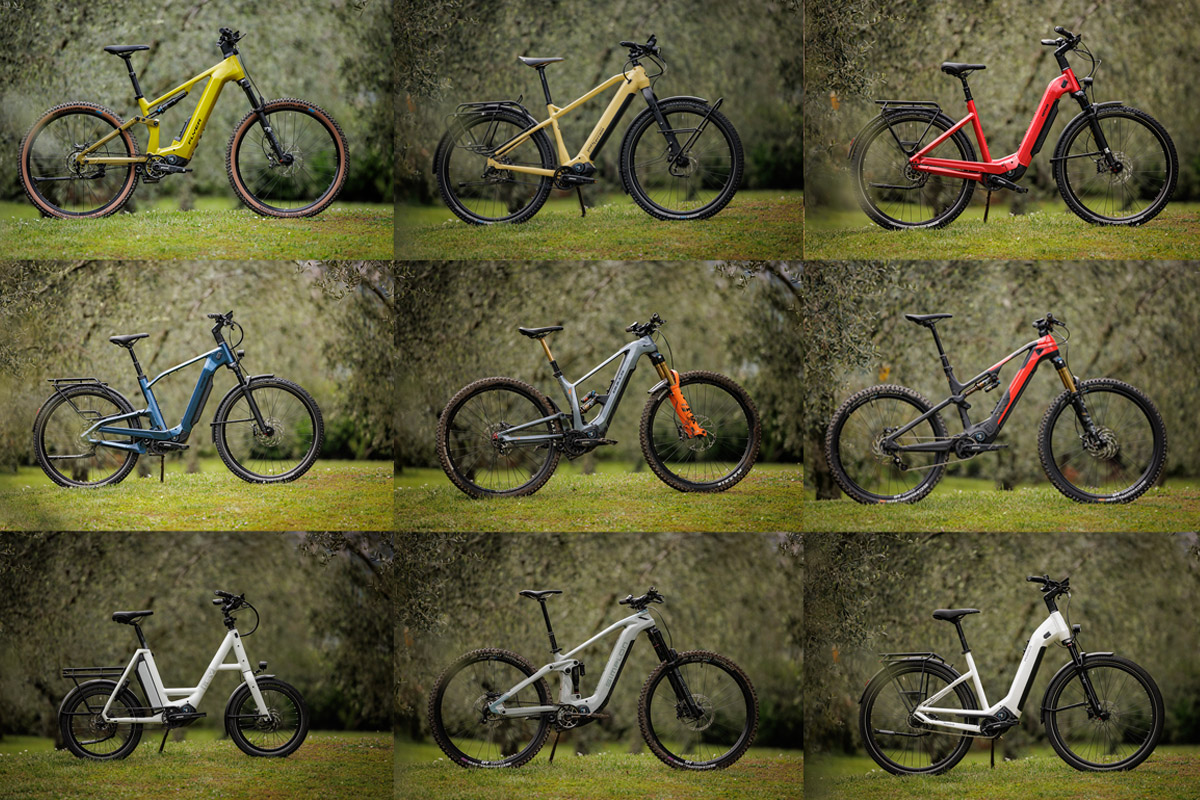
Alle E-Bikes mit Pinion MGU im Überblick: Vom Citybike bis zum Enduro E-MTB
Produktnews / E-Bikes: Mit der Vorstellung des Pinion E-Drive Systems sorgte der Hersteller aus Süddeutschland für einen Paukenschlag. Die Kombination aus Mittelmotor und Getriebeschaltung ist ein Novum auf dem Markt und eignet sich für unterschiedlichste Anwendungszwecke. In diesem Modelljahr führen neun namhafte Hersteller E-Bikes mit dem neuen Antriebssytem – wir haben alle im Überblick. Bulls […]
Pinion MGU: Wie schlägt sich der Antrieb im Test?
Wie alle marktrelevanten aktuellen Antriebe haben wir auch das Pinion E-Drive System ausführlich getestet, in der Praxis ebenso wie auf dem Prüfstand.
Das Pinion E-Drive System auf dem Prüfstand
Ein Blick auf die Maximalleistung der Pinion MGU zeigt, dass es sich um einen sehr kräftigen Mittelmotor handelt, der sogar Platzhirsche wie den Bosch Performance CX oder den Brose Drive S Mag auf die Plätze verweisen kann. Lediglich Power-Antriebe wie der TQ HPR120s bringen nochmals deutlich mehr Leistung. Bereinigt von der Verlustleistung des Systems (z.B. Reifen) erreichen wir übrigens eine reine Motorleistung von ca. 580 W, was sehr nahe an den Angaben von Pinion (600 W) liegt. Zudem wollten wir auch wissen, ob sich der eingelegte Gang des Systems auf die Maximalleistung auswirkt. Hier zeigen unsere Messungen, dass es sehr wohl Unterschiede gibt, diese jedoch im extremsten Fall bei ca. 60 W liegen – in der Praxis dürfte dies kaum spürbar sein.
Lenken wir den Blick weg von der „Extremsituation“ Maximalleistung und schauen uns ein alltäglicheres Szenario an – nämlich die Leistung bei nur 100 W Eingangsleistung – bestätigt sich das Bild: Mit ca. 580 W zählt der Pinion Antrieb auch hier zu den kräftigsten Vertretern am Markt und eignet sich sehr gut für diejenigen, die schon bei wenig Eigenleistung eine kräftige Unterstützung haben möchten.
Neben der abgegebenen Leistung messen wir auch den Verbrauch des Antriebs bzw. des Komplettsystems. Sowohl in der Ebene als auch am Berg konnten wir beim Pinion E-Drive System einen leicht überdurchschnittlichen Verbrauch feststellen. Man darf jedoch nicht vergessen: Die Gesetze der Physik gelten auch hier und da die Leistungsabgabe etwas höher ist als bei der Konkurrenz, ist es eigentlich auch nur logisch, dass der Energieverbrauch sich in einem ähnlichen Verhältnis bewegt.
Konkrete Aussagen zur Praxis lassen sich zwar nur bedingt ziehen, legen wir jedoch die von uns gemessenen Werte zu Grunde, darf man bei einem E-Bike mit Pinion MGU und 720 Wh Akku ungefähr die gleiche Reichweite erwarten, die ein Bike mit Bosch CX und 625 Wh Akku liefert. Kombiniert man die Pinion Einheit wiederum mit dem großen 960 Wh Akku, dürfte man ca. 15% weiter kommen als mit einem CX Antrieb und 750 Wh. Wie immer gilt jedoch: Die Reichweite hängt sehr vom individuellen Fahrstil, vom Terrain und dem jeweiligen Bike ab.
Die Pinion MGU im Praxistest
Wir hatten bereits Gelegenheit, verschiedene E-Bikes mit dem Pinion Antrieb vor der Vorstellung probezufahren. Neben zwei E-MTBs von Bulls und Simplon war auch ein Flyer TR:X SUV E-Bike dabei. Dabei fielen gleich mehrere Dinge auf: Das Schaltverhalten des integrierten Getriebes ist für Kettenschaltungs-Fahrer zunächst gewöhnungsbedürftig. Die Gangwechsel erfolgen tatsächlich in Sekundenbruchteilen und sind deutlich abrupter als bei einer Kettenschaltung.
Was sich im ersten Moment etwas unrund anfühlt, geht bereits nach wenigen Minuten in Fleisch und Blut über; sowohl die Geschwindigkeit der Gangwechsel als auch das Bewusstsein, dass diese zu jeder Zeit gleich zuverlässig erfolgen. Selbst unter Volllast muss man keine Einbußen hinnehmen und die Option, auch im Stand in die passende Übersetzung wechseln zu können, macht auch das Mountainbiker-Leben einfacher. Die Ergonomie des Triggers ist dabei wirklich gelungen, das Feedback beim Drücken auch mit Handschuhen sehr gut. Die Bandbreite des von uns getesteten 12-Gang Getriebes ist für quasi jede Situation mehr als ausreichend.
Viel Power und Feinfühligkeit
Wie sieht es mit dem Motor aus? Kann er in der Praxis die sehr überzeugende Vorstellung vom Prüfstand bestätigen? Ja – und wie! Ganz ehrlich: In einigen Situationen fühlt sich die Pinion MGU sogar noch kräftiger an, als es die von uns gemessenen Leistungswerte vermuten lassen. Insbesondere in einem Szenario, bei dem die meisten anderen Antriebe schwächeln, kann der Pinion Antrieb punkten: Niedrige Kadenz, schwerer Gang und das im Uphill. Mit überraschender Leichtigkeit werden wir auch in dieser Situation den Berg nach oben gezogen, klasse! Am anderen Ende des Spektrums, also bei hoher Kadenz sieht es sehr ähnlich aus. Auch bei 110 rpm konnten wir keinen spürbaren Leistungsverlust feststellen; Pinion selbst gibt an, dass der Antrieb bis zu einer Trittfrequenz von 120 ausgelegt ist.
Auch bei der Feinfühligkeit haben wir fast nur Positives zu berichten. Hier gefallen insbesondere die beiden adaptiven Fahrmodi Flex und Flow und erlauben eine feine Dosierung der Leistung. Bei der maximalen Unterstützung fiel dies deutlich schwerer, wobei dieses Verhalten typisch für quasi alle aktuellen Mittelmotoren sein dürfte.
Lautstärke abhängig vom eingelegten Gang
Eine etwas komplizierte Angelegenheit ist die Lautstärke des Antriebs. Auf der positiven Seite kann er auf alle Fälle die Abfahrt verbuchen. Wir konnten keinerlei Klappern in der Antriebseinheit feststellen und durch den Wegfall von Schaltwerk und dem Einsatz eines Riemens anstelle einer Kette gibt es auch hier keine unschönen Klapper-Geräusche. Die beiden von uns getesteten E-MTBs, das Bulls Vuca und das Simplon Rapcon pmax Pinion waren auf dem Trail leiser als viele nicht-motorisierte Mountainbikes.
Im Uphill gibt es ebenfalls Situationen, in denen der Antrieb angenehm leise ist, wenngleich ein hörbares Brummen immer vorhanden ist. In anderen Szenarien wird der Antrieb wiederum doch ziemlich laut – das ist abhängig von der Kadenz, der Unterstützungsleistung und auch dem eingelegten Gang. Gerade Letzteres ist eine Besonderheit des Pinion Systems und ist anfangs ziemlich ungewohnt. Durch die variierende Drehzahl des Motors abhängig von der Übersetzung gibt es beim Durchschalten durch das Spektrum immer wieder Gänge, in denen der Motor sehr viel lauter ist. Sobald man dann jedoch einen oder zwei Gänge nach oben oder unten schaltet, verbessert sich die Geräuschkulisse. Dieses Verhalten dürfte wohl nicht jedem gefallen, ist aber angesichts der vielen Vorteile des Getriebes absolut zu verschmerzen.
Pinion E-Drive System: Fazit
Mit dem E-Drive System sorgt Pinion quasi aus dem Stand als neuer Name im E-Bike Markt für einen Paukenschlag. Nicht nur ist die Kombination aus Getriebeschaltung und Mittelmotor einzigartig und bietet viele Vorteile. Auch die beiden Komponenten für sich sind beeindruckend: Riesige Übersetzungsbandbreite und ein feinfühliger, aber kräftiger Motor. Es fällt schwer, das Haar in der Suppe zu suchen – klar, für ein leichtes E-Bike dürfte es bessere Antriebe geben, aber für alles andere? Sollte die Pinion MGU die Versprechen auch bezüglich Wartung und Haltbarkeit erfüllen können, müssen sich selbst die großen Namen der Branche warm anziehen.

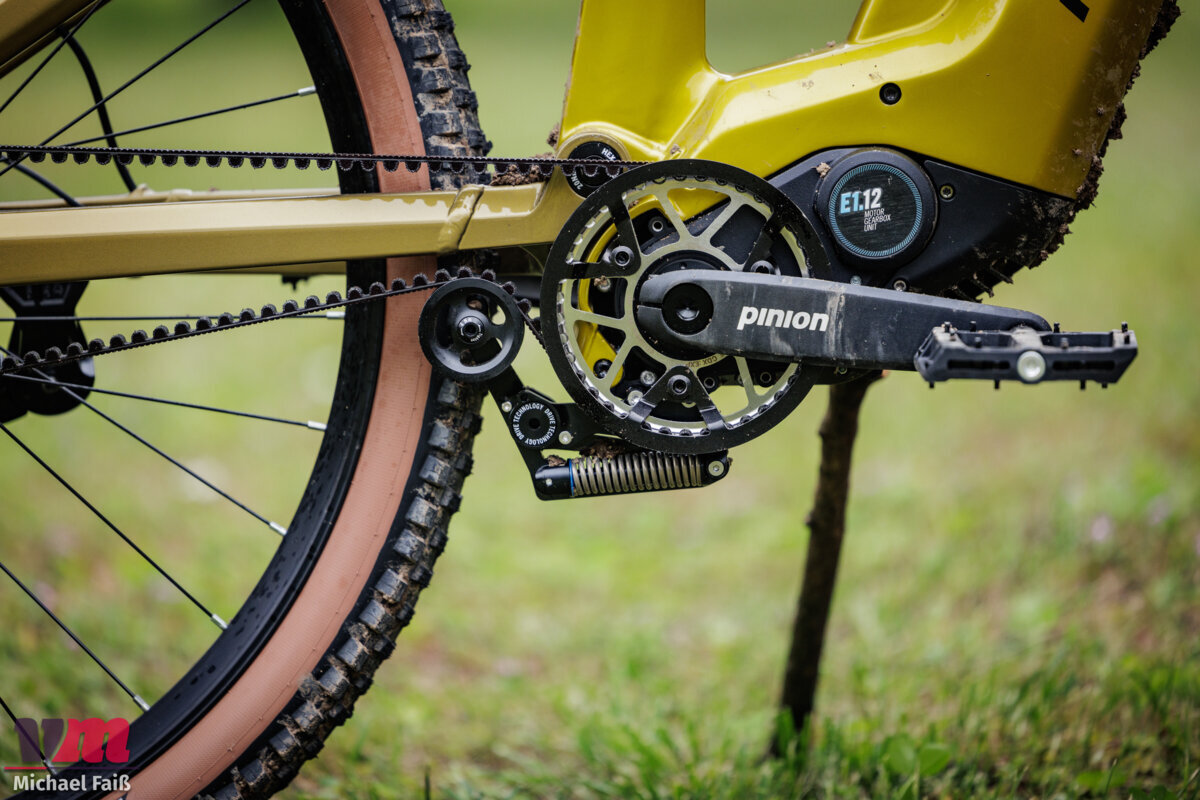
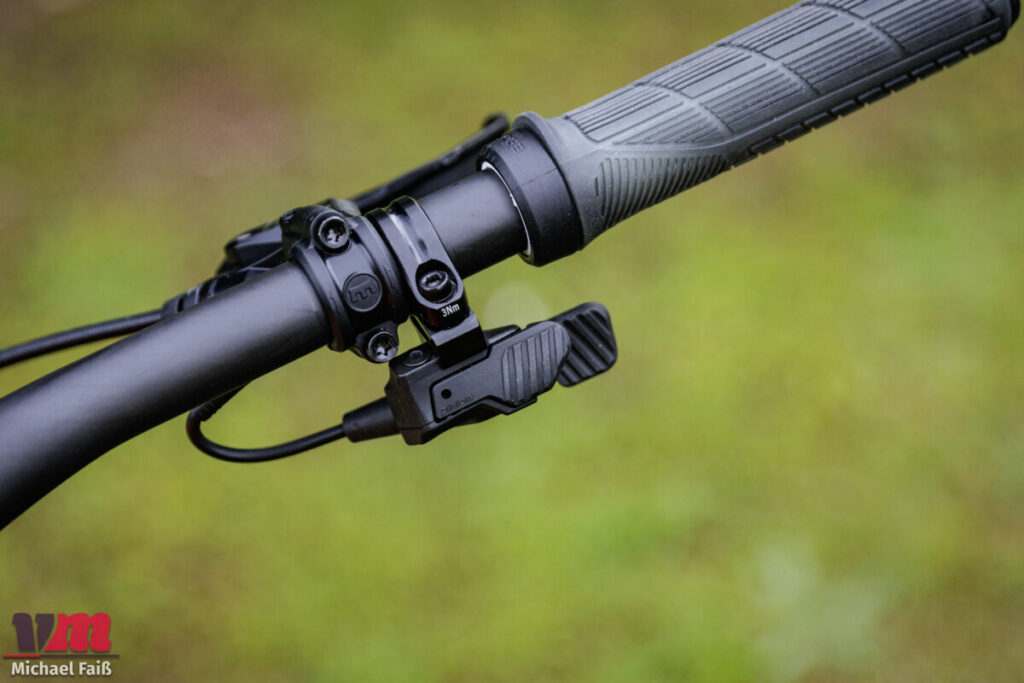





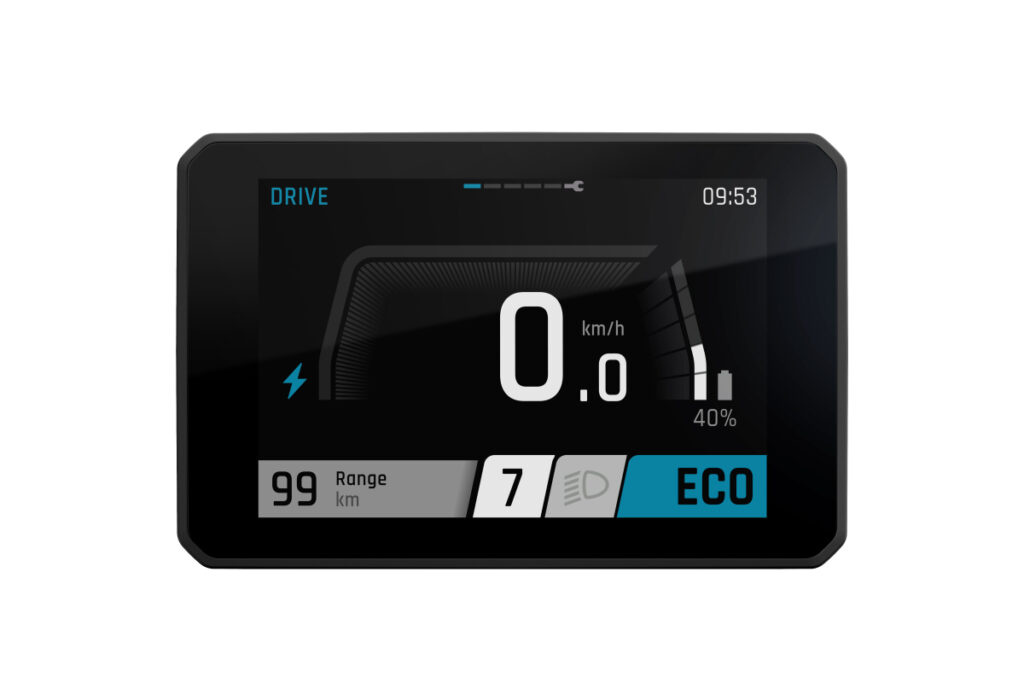

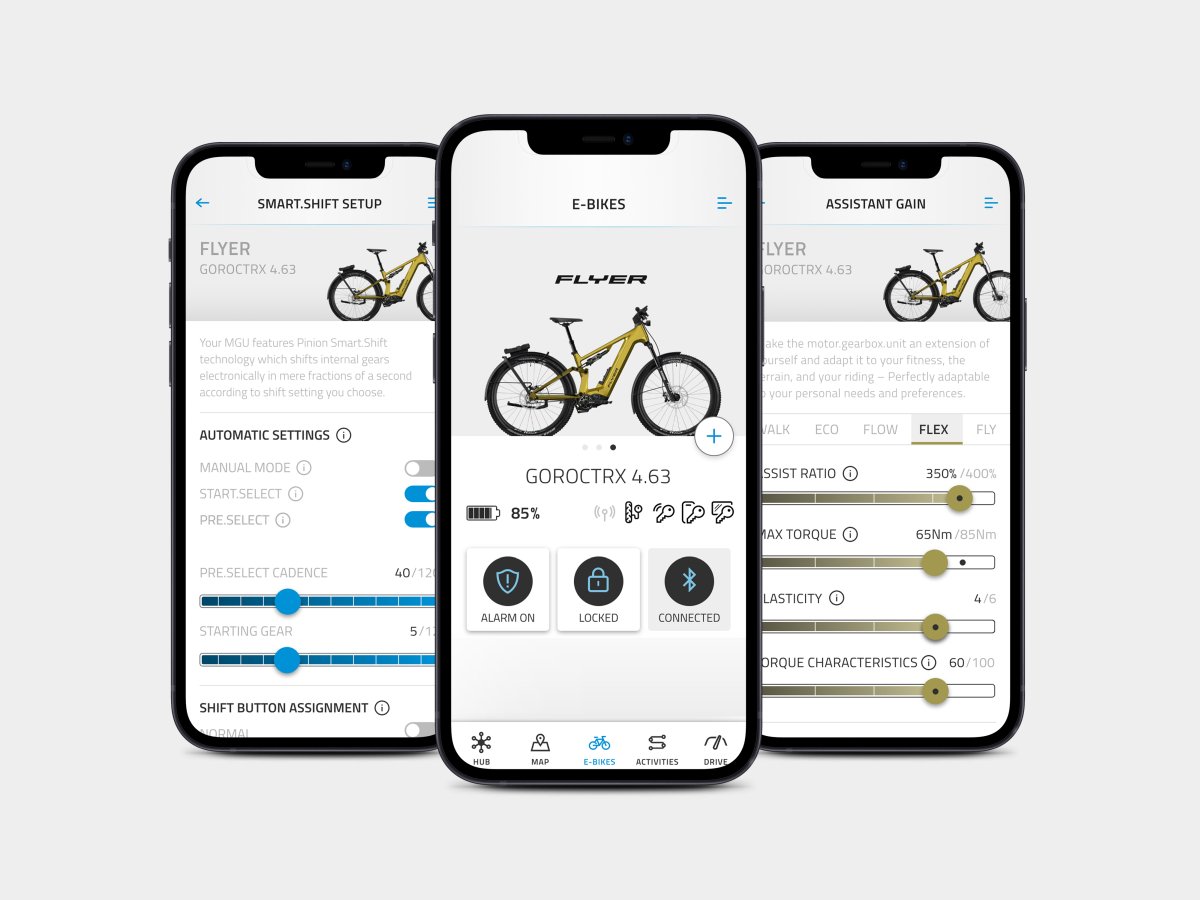
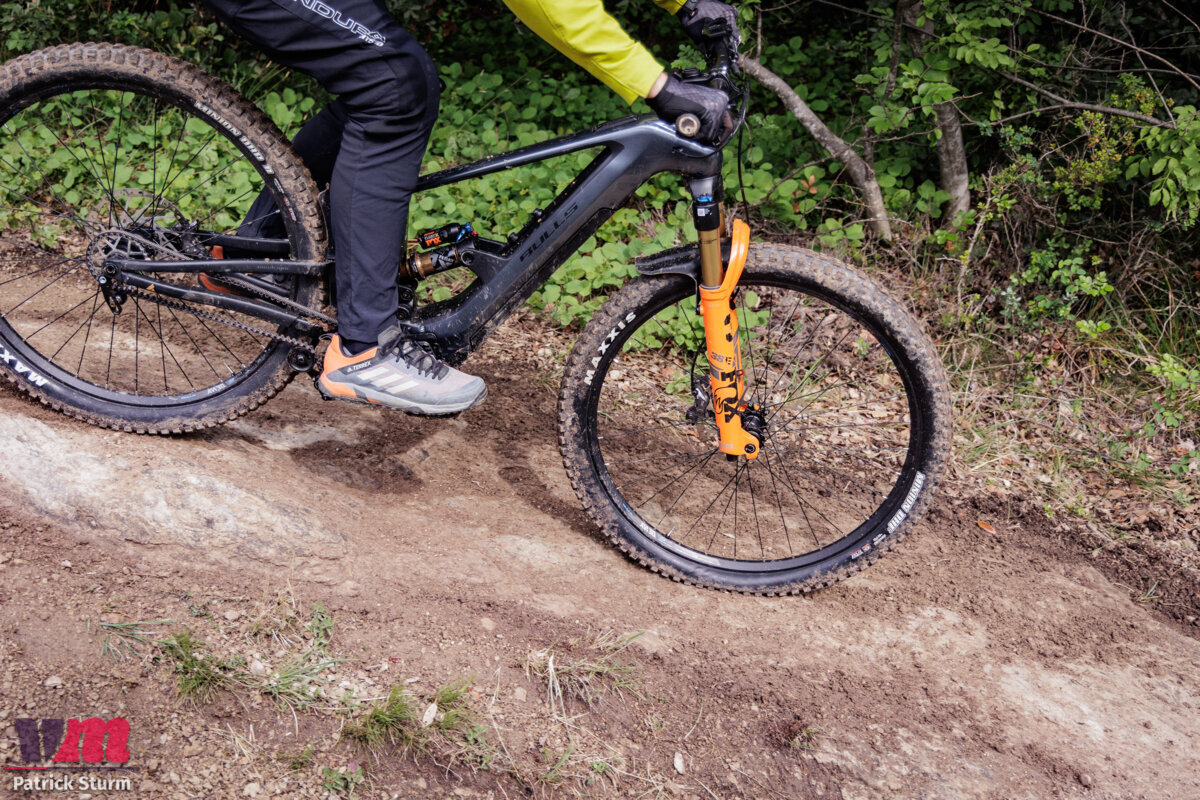
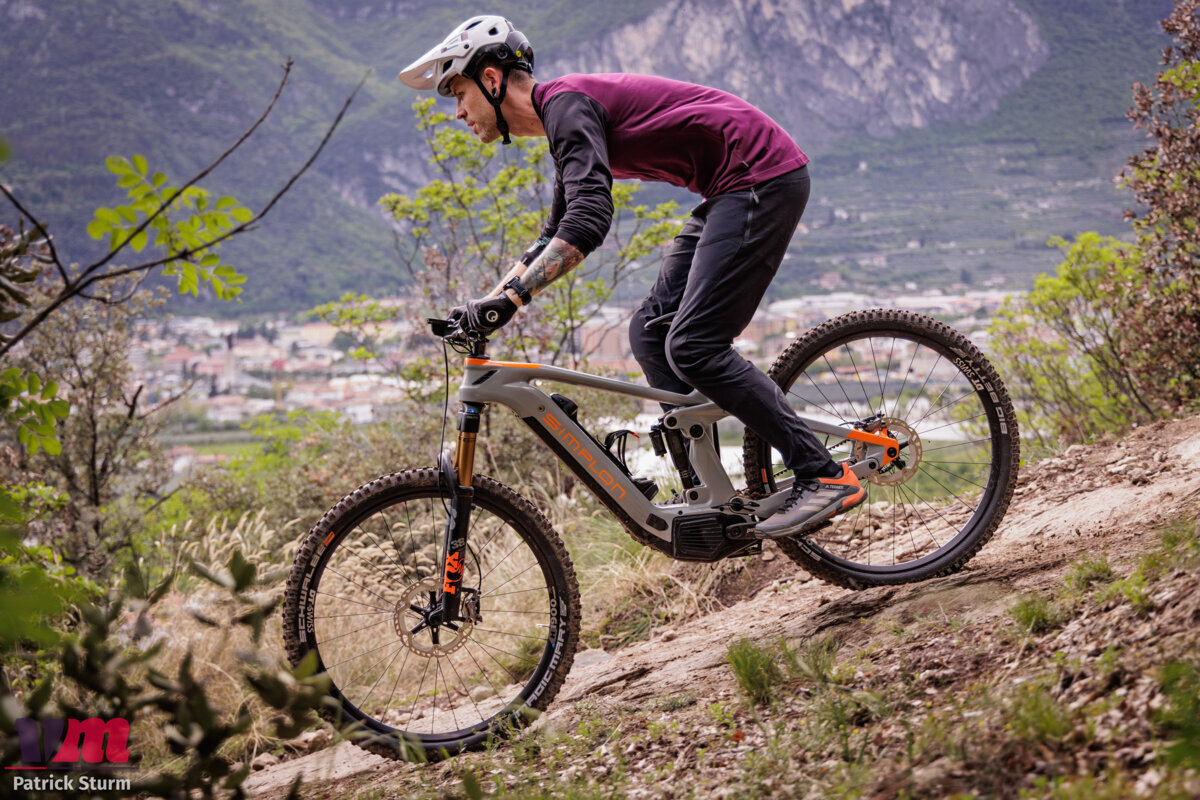
Herrmann says
Ich freue mich schon sehr auf eine Probefahrt. Bin gespannt!Möchte gerne mein E Bike nächstes Jahr tauschen. MfG
Stefan says
das hat nichts mehr mit Fahrrädern zu tun,das sind Mopeds mit Elektromotoren! nicht mein Ding, möchte lieber mit eigener Kraft und Puste einen Buckel hoch,ich liebe mein Fully…bin 78 und „alter“ Radsportler
Sancho says
Chapeau, ich hoffe ich kann das in 10 Jahren auch noch sagen.
Mik says
Ist auch günstiger
Roland Seher says
E-Bike fahren ist in meinen Augen sehr sportlich. Ich fahre täglich 30 – 40 Kilometer, seit 4 Jahren mit einem E-Bike. Letzteres fordert mich körperlich mehr wie die normalen Antriebe, mit dem gewaltigen Unterschied, dass es viel mehr Spaß macht, man im Notfall auch entspannt mit geringerem Kraftaufwand nach Hause kommt, aber genauso powern kann, dabei aber enorme Strecken zurück legt! Der Motor gibt mir das gleiche an Kraft dazu, was ich durch meine Muskelkraft erzeuge, so funktioniert dieses Prinzip. Liebe Grüße
Johannes Demmler says
Hallo
Da ich leider kein Rad habe hört sich das gut an
Viele Grüße
Cristián Kuhn says
Vielen Dank für diesen so ausführlichen Artikel!
Sehr interessant vor allem sehr erfreulich, dass beim Drahtesel doch noch eine Revolution dieses Kalibers möglich ist. Gerne hätte ich jedoch erfahren, wie sich diese auf den Endpreis des Rades niederschlagen wird.
Christian says
Vielen Dank für den ausführlichen und guten Artikel! Aber wie kann man die Preisgestaltung unerwähnt lassen? Wird so ein Bike im Vergleich zu anderen Systemen teuer oder billiger, und um wievielt? Ähnlich wie der Vergleich mit dem Gewicht.
LG, Christian
Stephan Weber says
Was ist eigentlich mit Rekuperation? Toll wäre auch ein Gasgriff, im Gelände kann man in Rinnen leider nicht immer treten. Beides wäre auf Elba ideal.
Andreas says
Hört sich soweit gut an, was ich aber vermisse,( oder vielleicht überlesen habe) , wie leichtgängig fährt es sich ohne Motorunterstützung. Bei Boschmotoren gab es auch enorme Unterschiede. Natürlich ist auch die Preisentwicklung interessant. Exklusivität ist mitunter ganz schön teuer.
Der Umdenker says
Warum Rekuperation immer noch kein Thema ist, ist mir unerklärlich. Ich wohne im Bergland und würde gerne davon profitieren. Daher interessiert mich alles was in Zukunft Ketten- und Zahnriemenlos daherkommt. Drive by Wire nennt sich das wohl. Das Tretlager ist nur noch ein Generator zusätzlich mit Akku-Unterstützung.
Sancho says
Für Rekuperation müsste die Energie halt irgendwie vom Laufrad zum Motor kommen, und ob man bei der Bergabfahrt eine rasende Kette mag?? Bei Mittelmotoren also schwierig…